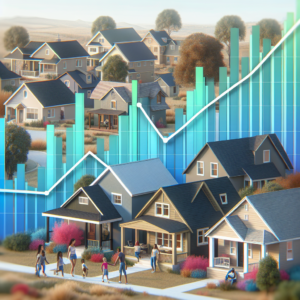
The commercial real estate (CRE) sector has long been a cornerstone of economic development, providing essential spaces for businesses to thrive. However, as the market evolves, investors and stakeholders must navigate a complex landscape filled with both hidden risks and emerging opportunities. This article delves into the intricacies of commercial real estate, highlighting key concepts, identifying potential pitfalls, and exploring avenues for growth, all while considering the role of economic indicators in shaping investment decisions.
Understanding the Landscape of Commercial Real Estate: An Overview of Key Concepts
Commercial real estate encompasses properties used exclusively for business purposes, including office buildings, retail spaces, industrial facilities, and multifamily housing. Unlike residential real estate, which is primarily concerned with individual housing needs, CRE focuses on generating income through leasing or selling space. Key concepts in this sector include property valuation, lease structures, market analysis, and investment strategies. Investors must familiarize themselves with various asset classes, understand the implications of zoning laws, and stay informed about local market trends to make sound investment decisions. Moreover, the rise of technology and data analytics has transformed how stakeholders assess property performance and market potential, making it imperative for investors to adapt to these advancements.
Identifying Hidden Risks in Commercial Real Estate Investments and Management Practices
While the potential for profit in commercial real estate is significant, it is accompanied by a range of hidden risks that can jeopardize investments. One of the most pressing concerns is market volatility, which can be exacerbated by economic downturns, changes in consumer behavior, and shifts in demand for specific property types. Additionally, investors must be wary of operational risks, such as property management inefficiencies, maintenance issues, and tenant defaults. Environmental risks, including compliance with regulations and potential liabilities from hazardous materials, also pose significant challenges. Furthermore, the rapid evolution of technology can render certain properties obsolete if they fail to adapt to modern standards. Understanding these risks is crucial for investors to develop robust strategies that safeguard their investments.
Opportunities for Growth: Emerging Trends in the Commercial Real Estate Market
Despite the inherent risks, the commercial real estate market is ripe with opportunities for growth, particularly in the wake of changing consumer preferences and technological advancements. The rise of e-commerce has spurred demand for logistics and distribution centers, while the increasing emphasis on sustainability has led to a surge in green building initiatives. Additionally, the shift towards remote work has transformed the office space landscape, prompting a reevaluation of traditional office designs and the emergence of flexible workspaces. Investors are also exploring mixed-use developments that combine residential, commercial, and recreational spaces to create vibrant communities. By staying attuned to these trends, investors can position themselves to capitalize on emerging opportunities that align with evolving market demands.
The Role of Economic Indicators in Assessing Commercial Real Estate Viability
Economic indicators play a pivotal role in assessing the viability of commercial real estate investments. Key metrics such as Gross Domestic Product (GDP), unemployment rates, and consumer spending provide insights into overall economic health and can influence demand for commercial properties. Additionally, interest rates and inflation rates directly impact financing costs and investment returns. Investors should also consider local economic conditions, including population growth, job creation, and infrastructure development, as these factors can significantly affect property values and rental income potential. By analyzing these indicators, investors can make informed decisions about when to enter or exit the market, ensuring that their investment strategies are aligned with broader economic trends.
Mitigating Risks: Strategies for Investors in Commercial Real Estate Ventures
To navigate the complexities of commercial real estate, investors must adopt proactive risk mitigation strategies. Diversification is a fundamental approach, allowing investors to spread their capital across various asset classes and geographic locations, thereby reducing exposure to market fluctuations. Conducting thorough due diligence is essential, including comprehensive property inspections, financial analysis, and tenant evaluations. Investors should also consider employing professional property management services to enhance operational efficiency and tenant satisfaction. Furthermore, staying informed about regulatory changes and market dynamics can help investors anticipate potential challenges and adapt their strategies accordingly. By implementing these risk mitigation strategies, investors can enhance their resilience in an unpredictable market.
Future Outlook: Navigating Challenges and Capitalizing on Opportunities Ahead
Looking ahead, the commercial real estate landscape is poised for transformation as it adapts to ongoing economic shifts and societal changes. The integration of technology, such as artificial intelligence and data analytics, will continue to reshape property management and investment strategies, enabling more informed decision-making. Additionally, the growing emphasis on sustainability and social responsibility will drive demand for eco-friendly developments and socially conscious investment practices. However, challenges such as rising interest rates, economic uncertainty, and evolving consumer preferences will require investors to remain agile and responsive. By embracing innovation and staying attuned to market trends, investors can navigate these challenges and capitalize on the myriad opportunities that lie ahead in the commercial real estate sector.
In conclusion, the commercial real estate market presents a complex interplay of risks and opportunities that require careful consideration from investors and stakeholders. By understanding the landscape, identifying hidden risks, and leveraging emerging trends, investors can position themselves for success in this dynamic sector. As economic indicators continue to shape the viability of commercial real estate investments, adopting strategic risk mitigation practices will be essential for navigating the challenges ahead. Ultimately, those who remain informed and adaptable will be best equipped to thrive in the evolving world of commercial real estate.



























